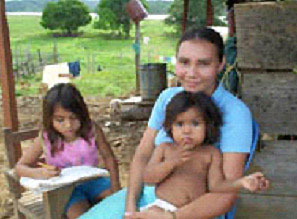You are here » Home » Telling Our Story
Success Story
Small dairy farmers join together to build a better future
Farms Swap Coca Crop for Dairy Products

| |
Photo: Land O’ Lakes
|
|
Cecilia Arboleda Jaramillo relaxes with her daughters at her family’s San Jose dairy farm.
“Milking dairy cows provides my family with a constant flow of income and nutrition,” said dairy farmer Cecilia Arboleda Jaramillo.
|
Colombia continues to be one of the world’s largest producers of coca, a plant used to produce cocaine. USAID, in collaboration with Land O’ Lakes, is helping to root out illicit crop production by helping farmers swap coca plants for dairy cows.
The program helps farmers switch to dairy production through a number of initiatives that include improving pastures, strengthening milk producer associations, and helping those associations build milk collection centers.
Many farming families have welcomed the chance to move into dairy farming with enthusiasm — the Jaramillo family in Antioquia is one of them. They joined the program to escape the violence and fear that comes with coca farming. Cecilia Arboleda Jaramillo said she vividly remembers threats of violence, as well as constant pressure from agents of the narcotraffickers, which made sure that her family barely scraped together a living off their farm. By contrast, now that initial production costs have been covered, her family earns a substantial income from dairy farming, and she feels safe.
Since the Jaramillo farm, “San José,” no longer produces coca, Cecilia has new hope. “Milking dairy cows provides my family with a constant flow of income and nutrition,” said Cecilia. Seven dairy cows graze on her lush, well-fenced pastures. The Jaramillos have built a new milking parlor and received training in hygienic milking practices, animal nutrition, and farm management.
Cecilia and her family are not alone. They belong to a growing movement of local dairy farmers who formed a cooperative, the Agricultural Association of Cáceres, which belongs to a larger association of dairy farmers that runs the local milk collection center. The 60 local dairy farms have increased their income by as much as 80 percent.
Thanks to improved farm practices, expanded milk collection centers, and better milk handling at those centers, Cecilia and her fellow milk producers are setting sales records and bringing their country one step closer to eradicating coca production.
Print-friendly version of this page (372kb - PDF)
Click here for high-res photo
Back to Top ^ | 

